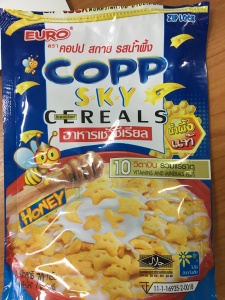One of the strongest motivations I have to learn Thai is so that I can expand my diet while I’m here. (Two years ago I subsisted mainly on fried rice and pad Thai.) Hence, I have bought flash cards that will teach me all the vegetables and fruits (to complement my coloring book of fruits). I am also working on reading menus on food stalls and ingredients lists on packages.

The flash cards are meant for Thai kids to learn English, hence the English name writ larger than the Thai. But it’s also useful for me, since I don’t actually know what all these fruits are called in English, let alone Thai.
A bonus I hadn’t expected is that a lot of Thai words for non-traditional foods are direct transliterations of English words. The coffee stand outside my office has a menu that is mostly translated (the proprietor knows a bit more English than most food vendors). One line at the end of the menu wasn’t translated, however, so I started sounding out the word I saw there: อิตาเลียนโซดา. By the time I got about halfway through, I realized it meant Italian soda, exactly what it sounds like. Some of the flavors I could have were กีวี่ (“gee-wee” aka kiwi) and แอปเปิ้ล (apple).
Since I have had some digestion issues that have prompted me to seek out simple carbohydrates, I am also reading packages of things like honeycomb-like cereal. A new word from that delicious snack is น้ำผึ้ง, which I guessed correctly means honey. How did I guess it? I know that น้ำ means water and ผึ้ง means bee… so honey is literally “bee-water.” I’ve been confirming my guesses with Google Translate, which also helped me learn that the word after honey is แท้, meaning genuine.

Across the top it reads “Copp Sky Flavor Honey.”
I was also in search of something like Gatorade since I knew I should be replenishing my electrolytes. I selected this beverage mainly because of its color. Then I started sounding out words on the label and realized (thanks to the help of some Facebook friends) that I had actually picked up a drink that has guarana in it (the words over the little beans to the left of Zaa) and is naturally caffeinated (the words under the beans). Apparently it does still work to keep me hydrated, but I should probably lay off it close to bed time.

The unnatural yellow color contrasts with the natural caffeine from the guarana beans. (Also comes in very unnatural purple color.)
The next challenge is to decipher this menu, from a roadside restaurant near the university. I think I should be able to read most of it, but the font makes some of the letters different from what I learned in class, making it a lot harder than it might otherwise be. I am very pleased I was able to spot pad Thai (top left of the first board) quickly, since that was what I actually wanted to eat today at lunch. But I know there are some delicacies that I could learn about, and since I’m vegetarian, I need to know which are straight up meat and which are mostly veg, noodles, or rice and could be easily modified with a request to not put in the meat.

There’s pad Thai at the top! Very delicious it was, too. Actually, I think the header indicates that this restaurant’s name has something to do with pad Thai, although I don’t know what the rest of it is.

This one starts with fried rice and gets more complicated. Lots of fried things (พ้ด) on this board.

Betsy, I give you a lot of credit. Living in another culture and learning the language and customs is all tall order for anyone.
Wow, this is amazing to me. I am very impressed with your learning curve, here. It’s all so—-foreign.
You’re doing a wonderful job – thanks for sharing these images and translations here. Very interesting.
How interesting. I am always fascinated with people who live in different countries and cultures and immerse themselves in it. I look at the menu and just wonder how you can read it…so I am really impressed.
S’watdee ka! I was a Peace Corps Volunteer in Thailand (2000-2002) so can speak and read Thai…but I’m a whole lot better at speaking it than reading it! I lived in Jangwat Uttaradit — Amphur Fak Tha — and was the only English speaker around for hours, so my Thai got pretty darn good. (I was there during the “hanging chad” election and had to explain the electoral system in Thai…that was hilarious and challenging!) How fun to come across this on Two Writing Teachers… Your words and the pictures brought back a flood of wonderful memories for me.
Kate, I totally remember trying to explain the US election of 2000 to people in Uzbekistan (where I was a PCV 1998-2000) and Turkmenistan (where I was watching the election returns while traveling). We started out telling everyone it would all be decided by about 6pm Eastern time (which was about 9am there), but then it dragged on and on and on… No one believed us that this wasn’t normal!
Ah the life of a PCB!!! But wait a second! You were in Uzbekistan? I wonder if you know a Diego that was there? (don’t want to say his last name but it actually is a famous name though he’s that That Diego if you know what I mean) He was my roommate for a bit before I met my husband and got married.
PCV I meant…too tired!
I don’t remember any Diegos famous or otherwise during my stint in Uz.